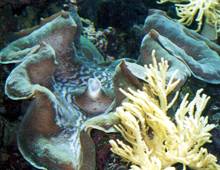
Tridacna gigas is the largest of the giant clam species, reaching more than 59 inches across in length and weighing more than 550 pounds. It is found on coral reefs throughout the Indo-Pacific, but may have become extinct in large parts of its former range. The adductor muscle of these clams is considered a delicacy in some areas, which has led to its overexploitation. Giant clams filter in microscopic plants and animals known as phytoplankton and zooplankton. Single celled phytoplankton, known as zooxanthellae, are photosynthetic and grow within the tissues of the clam providing it with nutrients and oxygen. For this reason, Giant clams are dependent upon light for survival.




